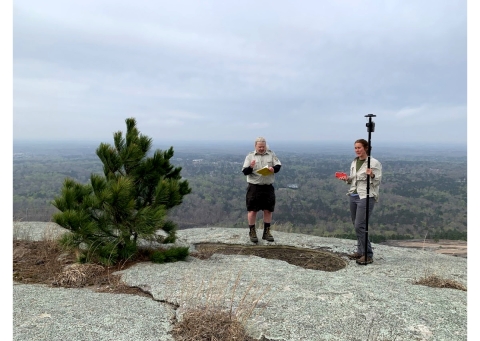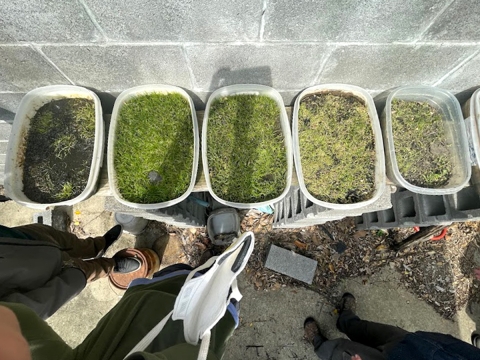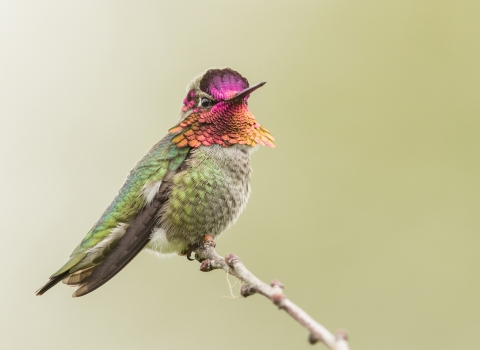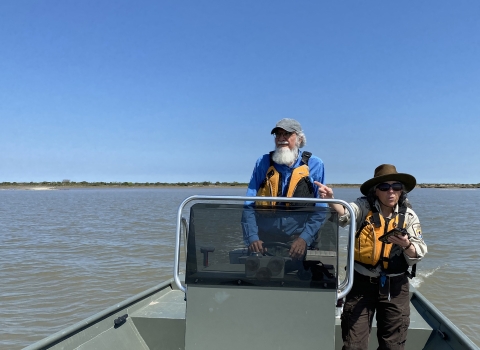On an overcast spring day in Georgia, botanists Mincy Moffett (USFWS Georgia Ecological Services) and Anna Wyngaarden (University of Georgia) met with Larry Winslett and Josh Griffith (Stone Mountain Memorial Association) on the summit of Stone Mountain, Dekalb County, Georgia to discuss the conservation status of the federally-endangered Black-spored Quillwort (Isoetes melanospora) and the federally-threatened Pool Sprite (Amphianthus pusilla [syn: Gratiola amphiantha]. These easy-to-overlook plants inhabit the granite rock outcrop pools on the mountain. Mincy and Anna's visit focused on assessing the current condition of the population, as well as on previous and planned granite rock outcrop “pool enhancement” projects in support of the conservation of the species.
The habitat is shallow, temporarily flooded, flat-bottomed pools formed by natural erosion on granite outcrops. The pools are seasonally inundated by winter and early spring rains and by seepage from surrounding habitats; they are usually completely dry during the summer and fall.
The key human-related threats to the plants that live here are quarrying, trash dumping, off-road-vehicle use, horseback riding, cattle trampling, development of woodlands surrounding granite outcrops, invasive plant species (on the rock and in the pools), and succession of outcrops (hastened by fire suppression and woody invasive species invasive species
An invasive species is any plant or animal that has spread or been introduced into a new area where they are, or could, cause harm to the environment, economy, or human, animal, or plant health. Their unwelcome presence can destroy ecosystems and cost millions of dollars.
Learn more about invasive species in the surrounding ecotone). Climate change is increasing both heat and drought stress on the rock and in the pools, as well as contributing to larger and more powerful precipitation events which are capable of scouring suitable pools of soil and plants.
A natural limiting factor of the habitat is the availability of “quality” pools capable of holding water long enough for the species to complete their annual life cycles. Many pools are too shallow, have a fatal crack in the substrate, have one edge or lip that is too low or compromised in some manner, are located in a high flow drainage area that leads to scouring during rain events, have a soil depth that is insufficient or excessive, or are overgrown with competing vegetation. With so much that could impede the plants' success, the plant conservation community in Georgia took the Goldilocks effect into their own hands and set out to create pools that could be "just right" for the plants.
In 2008, the community began experimenting with pool enhancement and repair techniques. The techniques and approaches vary depending on the specific condition of individual pools. In general, they involve deepening pools with concrete saws and jack hammers, repairing lips with cement, excavating and/or adding soil to an appropriate depth, removing competing vegetation, and inoculating pools with the target conservation species. Larry Winslett led this effort at Stone Mountain.
In the case of Stone Mountain Park, there are two naturally occurring pools of Black-spored quillwort. Beginning in 2008 and continuing today, the Stone Mountain Memorial Association, in cooperation with several partners, including the USFWS, has enhanced five additional pools on the summit of Stone Mountain for the quillwort. Plant material collected from one of the naturally occurring pools was propagated and multiplied at a secure area at the base of the mountain. It was used to inoculate some of the enhanced pools. The propagation work continues to this day.
Anna Wyngaarden is an graduate student researcher studying Plant Biology at the University of Georgia. Her thesis examines “Variance in Endemic Granite Outcrop Plant Populations Across Their Geographic Range”. She is also documenting the outcomes of all pool enhancement and safeguarding work on granite outcrops across Georgia from 2013 until present. To date, pool enhancement and safeguarding work has been conducted at Stone Mountain, Arabia Mountain, Greensboro South, and Heggies Rock. Mincy Moffett serves on Anna’s graduate committee. We look forward to learning more about the impacts of these conservation efforts as Anna continues this research.






